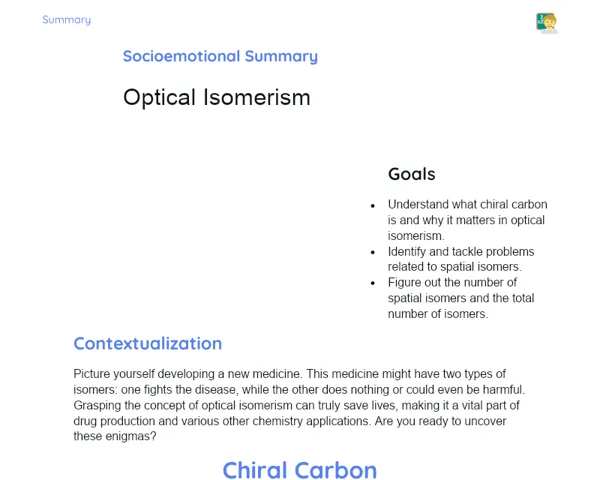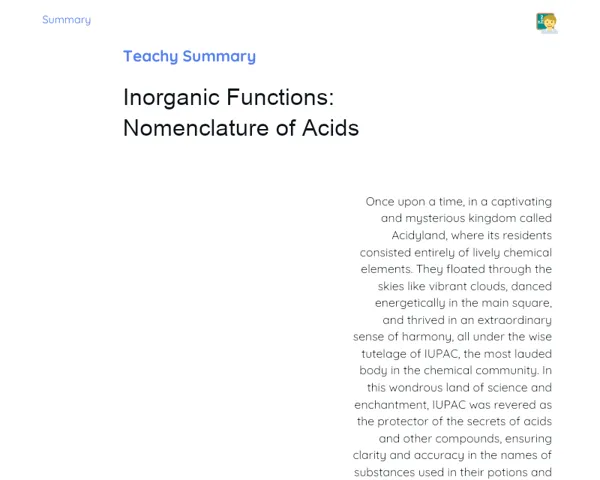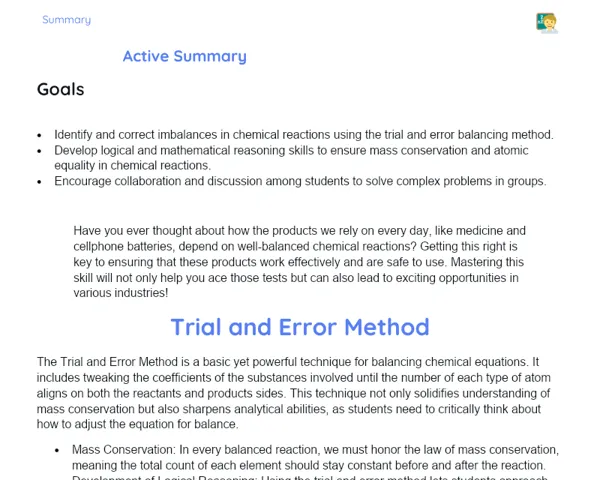Summary Tradisional | Thermochemistry: Enthalpy
Contextualization
Thermochemistry is a branch of chemistry that focuses on the heat exchanges that occur during chemical reactions. A key player in this area is enthalpy, a vital thermodynamic property that quantifies the amount of energy present in the form of heat within a system at constant pressure. Grasping the concept of enthalpy is crucial for understanding how energy moves and transforms during chemical reactions, which is useful in various fields like engineering, weather science, and biology.
Enthalpy, symbolised by H, is defined as the total internal energy of a system plus the product of pressure and volume. The change in enthalpy (ΔH) during a reaction signifies the difference between the enthalpy of the products and that of the reactants. This concept helps us distinguish between exothermic reactions, which give off heat (ΔH is negative), and endothermic reactions, which take in heat (ΔH is positive). Therefore, studying enthalpy not only enhances our understanding of the energy processes involved in chemical reactions but also aids in optimising these processes for industrial and technological advancements.
To Remember!
Definition of Enthalpy
Enthalpy (H) measures the total energy within a system, encompassing its internal energy as well as the energy needed for that system to fill a specific volume at constant pressure. The typical formula for enthalpy is H = U + PV, where U stands for internal energy, P denotes pressure, and V signifies volume. This idea is pivotal in thermochemistry, as it allows us to quantify the energy involved in both chemical and physical changes. Importantly, enthalpy is a state function, meaning its value relies solely on the current condition of the system, not the route it took to get there. This makes analysing energetic processes more straightforward, as we can calculate changes in enthalpy from the start to the end states without considering the path taken.
-
Enthalpy is the sum of internal energy and the product of pressure and volume.
-
General formula: H = U + PV.
-
It is a state function, dependent only on the current state of the system.
Change in Enthalpy (ΔH)
The change in enthalpy (ΔH) for a chemical reaction is found by calculating the difference between the enthalpy of the products and the enthalpy of the reactants. We express this with the formula ΔH = H_products - H_reactants, which allows us to figure out if a reaction is exothermic or endothermic. Exothermic reactions release heat, indicated by a negative ΔH, while endothermic reactions absorb heat, resulting in a positive ΔH. Understanding the change in enthalpy is key to grasping the energy processes that occur in chemical reactions, and it also helps predict how much heat is exchanged along with the thermal behaviour of the systems.
-
ΔH is the difference between the enthalpy of the products and that of the reactants.
-
Exothermic reactions have a negative ΔH.
-
Endothermic reactions have a positive ΔH.
Types of Enthalpy
Different types of enthalpy are specific to certain chemical processes. For instance, the enthalpy of formation (ΔHf) refers to the energy change when one mole of a compound forms from its elemental components in their standard state. The enthalpy of combustion (ΔHc) describes the energy change when one mole of a substance burns completely in oxygen. The enthalpy of neutralisation (ΔHn) occurs when an acid reacts with a base to produce one mole of water. Lastly, bond enthalpy (ΔHl) refers to the energy needed to break one mole of bonds in a gaseous molecule. These various enthalpy types allow us to analyse and predict how energy behaves during different chemical reactions, ultimately aiding in the formulation of safer and more efficient processes.
-
ΔHf: Enthalpy of formation.
-
ΔHc: Enthalpy of combustion.
-
ΔHn: Enthalpy of neutralisation.
-
ΔHl: Bond enthalpy.
Laws of Thermochemistry and Hess's Law
The laws governing thermochemistry, notably Hess's Law, are essential for interpreting changes in enthalpy during chemical reactions. Hess's Law states that the total change in enthalpy for a reaction equals the sum of the changes in enthalpy of each step constituting that reaction, no matter the path taken. This principle enables the calculation of the enthalpy for more complicated reactions using known enthalpies from simpler steps. For example, if a reaction can be deconstructed into various stages, the total enthalpy amounts to the total of those individual steps' enthalpies. This becomes incredibly useful when we need to determine the enthalpies of reactions that cannot be measured directly, relying instead on values from standard formation enthalpy tables.
-
Hess's Law helps calculate the change in enthalpy for complex reactions.
-
The total change in enthalpy is the cumulative change in enthalpy across individual steps.
-
It allows us to use data from intermediary reactions to determine enthalpies of reactions that can't be measured directly.
Enthalpy Diagrams
Enthalpy diagrams serve as visual aids that represent the energy changes during a chemical reaction. They display the enthalpy levels of both reactants and products, alongside the associated change in enthalpy (ΔH). In these diagrams, the disparity in enthalpy between reactants and products is illustrated, assisting in understanding exothermic versus endothermic reactions. For exothermic reactions, the product energy level appears lower than that of the reactants, indicating the release of heat. Conversely, endothermic reactions show products at a higher energy level than the reactants, signifying heat absorption. These diagrams prove valuable for visualising and comprehending the energetic behaviours of chemical reactions.
-
Enthalpy diagrams illustrate energy changes throughout chemical reactions.
-
Exothermic reactions have products at a lower energy level than the reactants.
-
Endothermic reactions have products at a higher energy level than the reactants.
Calculation of ΔH
Calculating the change in enthalpy (ΔH) typically involves using data from standard formation enthalpy tables. These tables provide standard formation enthalpy values (ΔHf) for various substances in their standard states. To derive the change in enthalpy for a reaction, we apply the formula ΔH = ΣΔHf(products) - ΣΔHf(reactants). This approach enables us to accurately ascertain the energy exchanges in chemical reactions based on previously acquired experimental measurements. By utilising standard formation enthalpy tables, the calculation of ΔH becomes attainable and applicable across a diverse range of chemical reactions, simplifying the analysis and planning of chemical processes.
-
Calculation of ΔH relies on data from standard formation enthalpy tables.
-
Formula: ΔH = ΣΔHf(products) - ΣΔHf(reactants).
-
This method is founded on previously measured experimental data.
Key Terms
-
Enthalpy (H): Measure of the total energy of a system.
-
Change in Enthalpy (ΔH): Difference between the enthalpy of the products and the reactants.
-
Exothermic Reaction: A reaction that releases heat (ΔH negative).
-
Endothermic Reaction: A reaction that absorbs heat (ΔH positive).
-
Enthalpy of Formation (ΔHf): Energy change when one mole of a substance forms from its elements in their standard state.
-
Enthalpy of Combustion (ΔHc): Energy change when one mole of a substance completely burns in oxygen.
-
Enthalpy of Neutralization (ΔHn): Energy change when an acid and a base react to produce one mole of water.
-
Bond Enthalpy (ΔHl): Energy needed to break one mole of bonds in a gaseous molecule.
-
Hess's Law: Total change in enthalpy equals the sum of enthalpy changes of individual steps.
-
Enthalpy Diagrams: Graphical representations illustrating changes in energy during a chemical reaction.
Important Conclusions
In this lesson, we delved into the notion of enthalpy, which is a crucial thermodynamic property measuring the energy in heat form within a system at constant pressure. We learned how to compute the change in enthalpy (ΔH) during chemical reactions, clarifying the differences between exothermic reactions that release heat and endothermic reactions that absorb heat. It became apparent that enthalpy is key to understanding how energy is exchanged and transformed in chemical processes, applicable in fields like engineering and biology.
We examined the various types of enthalpy, including formation, combustion, neutralisation, and bond enthalpy, each significant to different chemical processes. Moreover, Hess's Law was introduced as a valuable resource for deriving the enthalpy of complex reactions, leaning on enthalpy changes of intermediate reactions. Lastly, we presented enthalpy diagrams as a means of visualising energy transitions throughout chemical reactions.
Grasping the concept of enthalpy and its practical uses is vital for refining industrial operations and devising more efficient and sustainable technologies. The knowledge acquired during this lesson lays a robust foundation for energetic analyses and aids our understanding of everyday occurrences and technological processes. We encourage students to explore this subject further and apply the concepts they have learned across various scenarios.
Study Tips
-
Review the essential concepts surrounding enthalpy and their corresponding formulas, like H = U + PV and ΔH = ΣΔHf(products) - ΣΔHf(reactants).
-
Practice problem-solving involving the calculation of changes in enthalpy by using data from standard formation enthalpy tables and applying Hess's Law.
-
Utilise enthalpy diagrams to visualise and deepen your comprehension of energy shifts in chemical reactions, helping you distinguish between exothermic and endothermic reactions.



